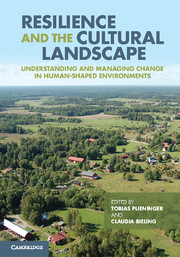 Resilience and the Cultural Landscape
Resilience and the Cultural Landscape Published online by Cambridge University Press: 05 November 2012
The problem
Europe is experiencing changes in agricultural landscapes. We are rapidly losing landscapes characterised by continuous human care and labour, high diversity in land use and, as consequence of that, a high biodiversity. Such landscapes are abandoned and replaced by urban development, forestry or large monotonous agricultural fields. At the same time, as a result of these changes, we are witnessing a growing awareness of the idea that the landscape is a common good, a good that public funds should be used to manage and sustain. Landscape has thus become a policy arena in Europe today. Landscape researchers are involved in applied research to a much greater extent than before. We are expected to assess the value of different landscapes, to give advice on how to preserve and manage landscapes and to contribute to landscape policies at regional, national and European levels.
For that we need good theories and good explanatory frameworks. Many would perhaps argue that, in this moment of rapid landscape change in Europe, we should put theoretical disagreements aside and, instead, focus on raising awareness and finding methods to preserve the few remains of such small-scale farming landscapes that we still have. I am of the opposite opinion: increased demand for applied research puts the theoretical and explanatory frameworks on centre stage. If we do not have sharp tools, theories and methods, our understanding of the cultural landscape will be shallow and our advice to policy makers most uncertain (Widgren, 2012). We need good theories that can explain the emergence, persistence and decline of particular types of farming systems and their accompanying landscapes.
To save this book to your Kindle, first ensure [email protected] is added to your Approved Personal Document E-mail List under your Personal Document Settings on the Manage Your Content and Devices page of your Amazon account. Then enter the ‘name’ part of your Kindle email address below. Find out more about saving to your Kindle.
Note you can select to save to either the @free.kindle.com or @kindle.com variations. ‘@free.kindle.com’ emails are free but can only be saved to your device when it is connected to wi-fi. ‘@kindle.com’ emails can be delivered even when you are not connected to wi-fi, but note that service fees apply.
Find out more about the Kindle Personal Document Service.
To save content items to your account, please confirm that you agree to abide by our usage policies. If this is the first time you use this feature, you will be asked to authorise Cambridge Core to connect with your account. Find out more about saving content to Dropbox.
To save content items to your account, please confirm that you agree to abide by our usage policies. If this is the first time you use this feature, you will be asked to authorise Cambridge Core to connect with your account. Find out more about saving content to Google Drive.